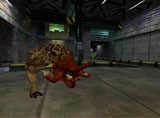 After three years and more
gaming awards than you can count, the PC FPS juggernaut Half-Life has finally been brought
onto a console system. The PS2 version features an exact port of the single player game,
spruced up with slightly improved graphics, motion capture, and a higher polygon count.
Also included are the all-new two-player cooperative game Decay and a two-player
head-to-head deathmatch.
After three years and more
gaming awards than you can count, the PC FPS juggernaut Half-Life has finally been brought
onto a console system. The PS2 version features an exact port of the single player game,
spruced up with slightly improved graphics, motion capture, and a higher polygon count.
Also included are the all-new two-player cooperative game Decay and a two-player
head-to-head deathmatch. It is hard to deny that when Half-Life was released in 1998 it
was a landmark in the FPS genre. Anyone who played video games felt the buzz surrounding
it. At the time, I was happy indulging in four-player FPS party games like Goldeneye. So,
I am among those who are taking advantage of the PS2 port as an opportunity to play the
game for the first time. Unfortunately, I have to say that at this point in next-gen
gaming Half-Life is at best a mediocre experience. I know that last statement goes against
everything that you have heard about the timelessness of the game, as well as the
predominantly positive reviews the PS2 port has received. I also know that this review
will irk many of the Half-Life true believers out there. So be it.
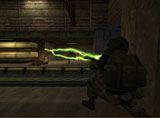 Let’s start with the positive. Everything that has been said about
Half-Life’s deliberate storytelling, eerie ambiance, and excellent level design is
true. The story places you in the role of Gordon Freeman, participant in a scientific
research project that has gone terribly wrong. The very fabric of space and time have been
torn, monsters are everywhere, and madness rules. It is up to you to put the pieces of
this dimensional puzzle back together and save the world. Of course, this is just the
set-up. The best story elements come as the game progresses, methodically, presenting you
with subtle clues and bizarre plot twists. Where many FPS games treat the story as
secondary, even expendable, Half-Life really wants you to settle in and enjoy.
Let’s start with the positive. Everything that has been said about
Half-Life’s deliberate storytelling, eerie ambiance, and excellent level design is
true. The story places you in the role of Gordon Freeman, participant in a scientific
research project that has gone terribly wrong. The very fabric of space and time have been
torn, monsters are everywhere, and madness rules. It is up to you to put the pieces of
this dimensional puzzle back together and save the world. Of course, this is just the
set-up. The best story elements come as the game progresses, methodically, presenting you
with subtle clues and bizarre plot twists. Where many FPS games treat the story as
secondary, even expendable, Half-Life really wants you to settle in and enjoy.
The ambiance is like that of your best sci-fi horror films. Alien comes to
mind. The game begins quietly, a normal day at work at the Black Mesa Research Facility,
until the unimaginable begins to tear the place apart. You must escape as the facility
falls to pieces—walls are crumbling, elevators filled with people fall before your
eyes, delicate equipment explodes all around you, and everywhere are bloody corpses and
monsters. Often you will enter a dark hallway with one flickering light source, and see a
woman’s legs dangling from the ceiling just before she is dragged up to her doom, or
a scientist scrambling around in his office to avoid a monster. This is great stuff.
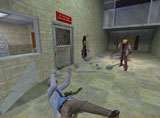 The level design in Half-Life is very organic and true-to-life. The Black Mesa
complex, where a great deal of your adventure takes place, doesn’t look or behave the
way most government facilities do in games. A lot of care has been taken to make this
place look as if it functions on its own, outside of the action of the game. It is hard to
explain other than to say that it contains rooms that have obvious functions in the real
world, but serve no real purpose in the game, and it has a protocol and security system
that functions consistently and independently of your character.
The level design in Half-Life is very organic and true-to-life. The Black Mesa
complex, where a great deal of your adventure takes place, doesn’t look or behave the
way most government facilities do in games. A lot of care has been taken to make this
place look as if it functions on its own, outside of the action of the game. It is hard to
explain other than to say that it contains rooms that have obvious functions in the real
world, but serve no real purpose in the game, and it has a protocol and security system
that functions consistently and independently of your character.
On the flip side of these few precious elements are a plethora of glaring problems that
make Half-Life almost too frustrating to bear. Sure, what the story has to offer in the
long run is the best there is, but the pacing is terrible. The game begins with a train
ride to Black Mesa that seems to go on forever. There is some humor in the laundry list of
propaganda that is fed to you over the PA system, but otherwise it functions as nothing
more than a credits sequence, and you can’t skip it. After the train you have to make
your way through security and find your way around the facility. This will take some time.
Then you have to put on your Hazardous Environment Suit. Then you have to listen to a
couple of scientists brief you on today’s protocol. Then you perform some menial
tasks in the testing room. Finally, after that, things begin to happen. But it is still a
matter of time before you get your first weapon (a crowbar) and even longer before you get
a gun. In all, I defy you to kill your first monster in less than twenty minutes, more
likely thirty. And this is not the only slow time in the game.
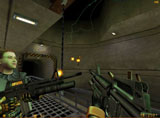 The ambiance is perfect, but your suspension of disbelief will be tested to the
extreme by constant, irritating load times. The game functions in a continuous narrative,
sans "levels," much like Red Faction
(actually Red Faction borrowed that from Half-Life, but never mind). The load times are
short, only a matter of seconds really, but they happen every few minutes, and in the
worst places. For example, when things first start to go wrong at Black Mesa you are in
the testing room, pushing an element into a beam of light. Then, boom! The room rumbles
and begins to fall apart. Sirens blare. And then…silence, darkness, your heartbeat.
You are in another world, surrounded by monsters. You are then ripped back into the chaos
of the testing room, and then back to the blackness. Several large monsters stare at you.
Then…a load screen. Ugh. They have you! It’s perfect! Then it’s as if the
lights have come on in the theater. You are instantly and undeniably aware that you are
only playing a game, and that sucks. I would much rather have had the more intrusive, but
strategically placed load screens of Red Faction, than constant unwelcome jolts out of the
story.
The ambiance is perfect, but your suspension of disbelief will be tested to the
extreme by constant, irritating load times. The game functions in a continuous narrative,
sans "levels," much like Red Faction
(actually Red Faction borrowed that from Half-Life, but never mind). The load times are
short, only a matter of seconds really, but they happen every few minutes, and in the
worst places. For example, when things first start to go wrong at Black Mesa you are in
the testing room, pushing an element into a beam of light. Then, boom! The room rumbles
and begins to fall apart. Sirens blare. And then…silence, darkness, your heartbeat.
You are in another world, surrounded by monsters. You are then ripped back into the chaos
of the testing room, and then back to the blackness. Several large monsters stare at you.
Then…a load screen. Ugh. They have you! It’s perfect! Then it’s as if the
lights have come on in the theater. You are instantly and undeniably aware that you are
only playing a game, and that sucks. I would much rather have had the more intrusive, but
strategically placed load screens of Red Faction, than constant unwelcome jolts out of the
story.
Even the level design lags at times, especially during the platform-like, jumping from
ledge to ledge elements that plague the middle of the game. Here, the game gets really
tedious as you jump a ledge, flip a switch, and then search for the next ledge or switch
or whatever.
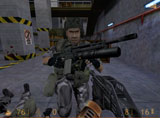 The AI is uneven. At its best, when the government agents are hunting you, it
is terrific. They behave intelligently and with purpose. They track you, lure you, and
surround you. They even try their best not to die—diving behind cover, running away,
moving to a new position. Most of the monsters, however, just leap at you or give chase.
And the friendly AI is pathetic. For instance, during the first portion of your escape
from Black Mesa you come to a security guard that you must save so that he can let you
through a gate. Once he lets you through, you can approach him and press your action
button and he will say something like "sure, I’ll follow you." Press the
button again he says, "no, I better stay here." Press it again, "maybe we
better stick together." It is like hitting an on/off switch rather than talking to a
character. Then, when he follows you he walks into walls, and runs around backwards and in
circles. He cannot move through some spaces big enough for him, will not follow you into
some rooms, and even when he does you must open the right door for him. Not just a
door—the right door. At one point in the game there are two double doors, you’re
on one side, he’s on the other, and you must let him in. But if you open the one
directly in front of him, he blocks it and it closes and locks for good. Open the one
right next to that and he still continues to ram the other closed door over and over until
you manage to lure him into the other open door! And just count yourself lucky if the jerk
doesn’t accidentally shut that one and lock it, too. The only way any of this is
tolerable, and you must tolerate it as much of the story is conveyed by NPCs that give you
clues or items, is if you treat it like a joke and laugh with it. I had more fun saving my
progress, then going back and setting up traps for this idiot, and others like him, and
watching them die, than I did playing the rest of the game.
The AI is uneven. At its best, when the government agents are hunting you, it
is terrific. They behave intelligently and with purpose. They track you, lure you, and
surround you. They even try their best not to die—diving behind cover, running away,
moving to a new position. Most of the monsters, however, just leap at you or give chase.
And the friendly AI is pathetic. For instance, during the first portion of your escape
from Black Mesa you come to a security guard that you must save so that he can let you
through a gate. Once he lets you through, you can approach him and press your action
button and he will say something like "sure, I’ll follow you." Press the
button again he says, "no, I better stay here." Press it again, "maybe we
better stick together." It is like hitting an on/off switch rather than talking to a
character. Then, when he follows you he walks into walls, and runs around backwards and in
circles. He cannot move through some spaces big enough for him, will not follow you into
some rooms, and even when he does you must open the right door for him. Not just a
door—the right door. At one point in the game there are two double doors, you’re
on one side, he’s on the other, and you must let him in. But if you open the one
directly in front of him, he blocks it and it closes and locks for good. Open the one
right next to that and he still continues to ram the other closed door over and over until
you manage to lure him into the other open door! And just count yourself lucky if the jerk
doesn’t accidentally shut that one and lock it, too. The only way any of this is
tolerable, and you must tolerate it as much of the story is conveyed by NPCs that give you
clues or items, is if you treat it like a joke and laugh with it. I had more fun saving my
progress, then going back and setting up traps for this idiot, and others like him, and
watching them die, than I did playing the rest of the game.
The interface is pretty standard, and in most cases, good. The menu screens are easy
and intuitive. The game has two save features—a quick save that temporarily saves
your progress, but will be lost if you reset or turn off the PS2, and a permanent save to
the memory card when you are finished playing. The default controls are like those of
every other PS2 FPS—walk with the left analog joystick, look and turn with the right,
fire weapons with R1 and R2, jump and duck with L1 and L2, etc. You can change the
control, and, if you prefer, Half-Life even supports a USB keyboard and mouse. The
movement is a little unconvincing. Freeman doesn’t seem to walk as much as glide, as
if he is on ice-skates. And the collision detection is pretty bad. Many monsters just
swing at you with their claws, and often seem to hit you even after they are well out of
reach.
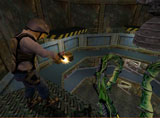 The add campaign for this PS2 port boasts improved graphics. I am not sure
exactly how the 1998 PC version performed, but I know that the updated graphics are not
even close to what can be done on the PS2, or has been done, for that matter. Just look at
the detailed, expressive facial models in 007: Agent Under Fire.
And compared to the phenomenal graphics of Xbox’s HALO,
forget it. That is a game where the closer you get to objects, the more rich and detailed
they become. If you look down at your feet in Halo, you will see individual blades of
grass! Half-Life, on the other hand, is one of those games where when you get too close,
the graphics get real ugly. Face to face everything looks like a garbled, blocky mess. The
character models get pretty ridiculous after awhile. They aren’t bad, just absurdly
repetitive. I am used to seeing the same standard soldier over and over, but usually it is
easy to ignore because they are generic enough that they don’t stand out, or they
have faceplates, or something. But the scientists of Black Mesa are like a bad gag. There
are only three different character models for the dozens of them that you run
into—the wild-haired old guy, the African-American with salt-and-pepper hair, and the
Carson Daly wannabe. They are not generic at all, and you run into them constantly,
sometimes right next to their twin. They even have the same voices! Their movements are
stiff, repetitive, and jerky as well. Most of the monsters are impressive, though, once
you get past the initial onslaught of head-grabbers that look like raw, store-bought
turkeys with giant mouths. The best thing about the graphics is that no matter how much is
going on, and usually there is a lot going on, the game runs at a smooth 60fps.
The add campaign for this PS2 port boasts improved graphics. I am not sure
exactly how the 1998 PC version performed, but I know that the updated graphics are not
even close to what can be done on the PS2, or has been done, for that matter. Just look at
the detailed, expressive facial models in 007: Agent Under Fire.
And compared to the phenomenal graphics of Xbox’s HALO,
forget it. That is a game where the closer you get to objects, the more rich and detailed
they become. If you look down at your feet in Halo, you will see individual blades of
grass! Half-Life, on the other hand, is one of those games where when you get too close,
the graphics get real ugly. Face to face everything looks like a garbled, blocky mess. The
character models get pretty ridiculous after awhile. They aren’t bad, just absurdly
repetitive. I am used to seeing the same standard soldier over and over, but usually it is
easy to ignore because they are generic enough that they don’t stand out, or they
have faceplates, or something. But the scientists of Black Mesa are like a bad gag. There
are only three different character models for the dozens of them that you run
into—the wild-haired old guy, the African-American with salt-and-pepper hair, and the
Carson Daly wannabe. They are not generic at all, and you run into them constantly,
sometimes right next to their twin. They even have the same voices! Their movements are
stiff, repetitive, and jerky as well. Most of the monsters are impressive, though, once
you get past the initial onslaught of head-grabbers that look like raw, store-bought
turkeys with giant mouths. The best thing about the graphics is that no matter how much is
going on, and usually there is a lot going on, the game runs at a smooth 60fps.
This brings me to the single biggest faux pas of the game: it has the worst multiplayer
support of any FPS in recent memory. The Head-To-Head Mode is so limited it is almost
useless. Gameplay consists of two-player deathmatches only. There are just six characters
and ten levels to choose from. On top of that, the only adjustable options are the kill
limit and time limit. There are no capture the flag, hold the bag, or other popular games,
and no bots. To add insult to injury the in-game view doesn’t even show your gun as
it is held by your character. Instead, there is a gun icon in the corner that tells you
which gun you have, and a detached muzzle flash in the center of the screen. For the life
of me, I cannot imagine a reason for this. It has nothing to do with graphics performance,
or it would happen more often.
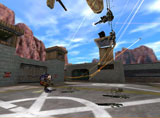 Decay is a two-player cooperative game. The missions contain puzzles and combat
situations suited for two people, and at the end of each mission, players are rated on
accuracy, kills, and damage sustained. The problems here begin with the fact that it
starts much like the single-player game, with a twenty minute-or-so opening sequence that
is boring as hell. Then you both get crowbars and go after some turkey-things. It takes a
while to get a gun, and most of my friends simply were unwilling to sit through it. They
wanted to pick up a gun and go for some two-player cooperative glory, not sit on their
hands for twenty minutes and then swing a crowbar at turkeys. Also, if you want to go
through it on your own, the computer doesn’t even control the other player. You have
to play as both, taking turns, switching from on to the other by pressing the select
button. It even does that no-gun thing here, too. This is just lame.
Decay is a two-player cooperative game. The missions contain puzzles and combat
situations suited for two people, and at the end of each mission, players are rated on
accuracy, kills, and damage sustained. The problems here begin with the fact that it
starts much like the single-player game, with a twenty minute-or-so opening sequence that
is boring as hell. Then you both get crowbars and go after some turkey-things. It takes a
while to get a gun, and most of my friends simply were unwilling to sit through it. They
wanted to pick up a gun and go for some two-player cooperative glory, not sit on their
hands for twenty minutes and then swing a crowbar at turkeys. Also, if you want to go
through it on your own, the computer doesn’t even control the other player. You have
to play as both, taking turns, switching from on to the other by pressing the select
button. It even does that no-gun thing here, too. This is just lame.
What this comes down to is that Half-Life, while spooky and interesting, just
isn’t that much fun to play. This port comes after the technologically superior Red
Faction (which introduced gamers to Geo-Mod) and the awe-inspiring X-box FPS, HALO. You
spend a lot of your time waiting for things to happen. In the beginning of the game you
pretty much just swat turkeys with your crowbar and the middle focuses too much platform
jumping and predictable puzzles. The load screens, which appear every few
minutes—nearly every time you reach the end of a hallway or enter a door—destroy
your immersion into the game. The friendly AI is unbearable. To top it all off, the
multiplayer games offer little variety and no real replay value. As most gamers can finish
this game within a five day rental period, that is about all I can recommend, and even
then, for FPS addicts only.
